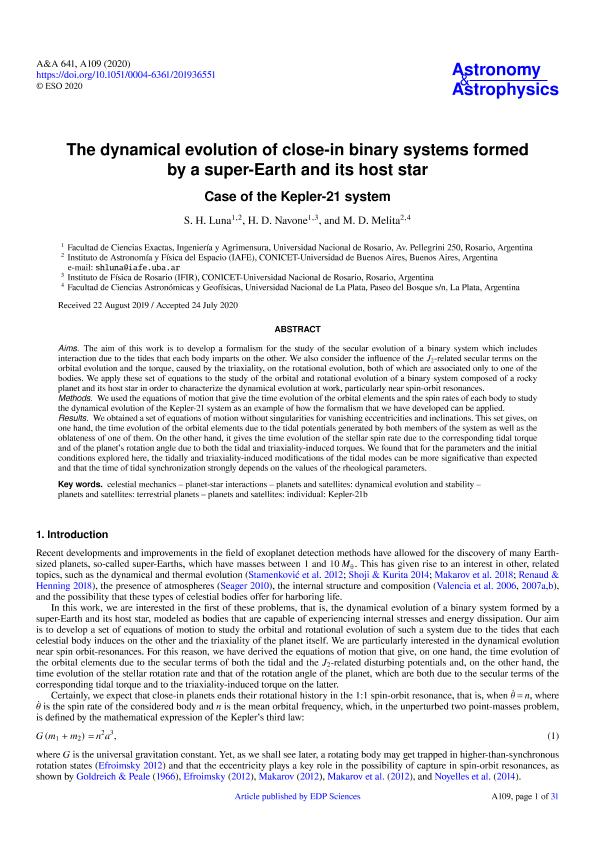Mostrar el registro sencillo del ítem
dc.contributor.author
Luna, Santiago Hernan

dc.contributor.author
Navone, Hugo Daniel

dc.contributor.author
Melita, Mario Daniel

dc.date.available
2020-10-29T20:18:22Z
dc.date.issued
2020-09
dc.identifier.citation
Luna, Santiago Hernan; Navone, Hugo Daniel; Melita, Mario Daniel; The dynamical evolution of close-in binary systems formed by a super-Earth and its host star: Case of the Kepler-21 system; EDP Sciences; Astronomy and Astrophysics; 641; 9-2020; 1-31
dc.identifier.issn
0004-6361
dc.identifier.uri
http://hdl.handle.net/11336/117197
dc.description.abstract
Aims. The aim of this work is to develop a formalism for the study of the secular evolution of a binary system which includes interaction due to the tides that each body imparts on the other. We also consider the influence of the J2-related secular terms on the orbital evolution and the torque, caused by the triaxiality, on the rotational evolution, both of which are associated only to one of the bodies. We apply these set of equations to the study of the orbital and rotational evolution of a binary system composed of a rocky planet and its host star in order to characterize the dynamical evolution at work, particularly near spin-orbit resonances. Methods. We used the equations of motion that give the time evolution of the orbital elements and the spin rates of each body to study the dynamical evolution of the Kepler-21 system as an example of how the formalism that we have developed can be applied. Results. We obtained a set of equations of motion without singularities for vanishing eccentricities and inclinations. This set gives, on one hand, the time evolution of the orbital elements due to the tidal potentials generated by both members of the system as well as the oblateness of one of them. On the other hand, it gives the time evolution of the stellar spin rate due to the corresponding tidal torque and of the planet’s rotation angle due to both the tidal and triaxiality-induced torques. We found that for the parameters and the initial conditions explored here, the tidally and triaxiality-induced modifications of the tidal modes can be more significative than expected and that the time of tidal synchronization strongly depends on the values of the rheological parameters.
dc.format
application/pdf
dc.language.iso
eng
dc.publisher
EDP Sciences

dc.rights
info:eu-repo/semantics/openAccess
dc.rights.uri
https://creativecommons.org/licenses/by-nc-sa/2.5/ar/
dc.subject
celestial mechanics
dc.subject
planet-star interactions
dc.subject
planets and satellites: dynamical evolution and stability
dc.subject
tidal evolution
dc.subject.classification
Astronomía

dc.subject.classification
Ciencias Físicas

dc.subject.classification
CIENCIAS NATURALES Y EXACTAS

dc.title
The dynamical evolution of close-in binary systems formed by a super-Earth and its host star: Case of the Kepler-21 system
dc.type
info:eu-repo/semantics/article
dc.type
info:ar-repo/semantics/artículo
dc.type
info:eu-repo/semantics/publishedVersion
dc.date.updated
2020-09-30T17:04:52Z
dc.journal.volume
641
dc.journal.pagination
1-31
dc.journal.pais
Francia

dc.journal.ciudad
Paris
dc.description.fil
Fil: Luna, Santiago Hernan. Consejo Nacional de Investigaciones Científicas y Técnicas. Oficina de Coordinación Administrativa Ciudad Universitaria. Instituto de Astronomía y Física del Espacio. - Universidad de Buenos Aires. Facultad de Ciencias Exactas y Naturales. Instituto de Astronomía y Física del Espacio; Argentina. Universidad Nacional de Rosario. Facultad de Ciencias Exactas, Ingeniería y Agrimensura; Argentina
dc.description.fil
Fil: Navone, Hugo Daniel. Universidad Nacional de Rosario. Facultad de Ciencias Exactas, Ingeniería y Agrimensura; Argentina. Consejo Nacional de Investigaciones Científicas y Técnicas. Centro Científico Tecnológico Conicet - Rosario. Instituto de Física de Rosario. Universidad Nacional de Rosario. Instituto de Física de Rosario; Argentina
dc.description.fil
Fil: Melita, Mario Daniel. Universidad Nacional de La Plata. Facultad de Ciencias Astronómicas y Geofísicas; Argentina. Consejo Nacional de Investigaciones Científicas y Técnicas. Oficina de Coordinación Administrativa Ciudad Universitaria. Instituto de Astronomía y Física del Espacio. - Universidad de Buenos Aires. Facultad de Ciencias Exactas y Naturales. Instituto de Astronomía y Física del Espacio; Argentina
dc.journal.title
Astronomy and Astrophysics

dc.relation.alternativeid
info:eu-repo/semantics/altIdentifier/url/https://www.aanda.org/10.1051/0004-6361/201936551
dc.relation.alternativeid
info:eu-repo/semantics/altIdentifier/doi/http://dx.doi.org/10.1051/0004-6361/201936551
Archivos asociados
